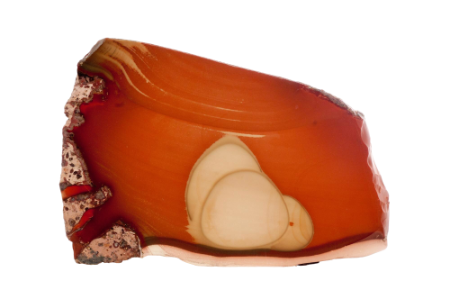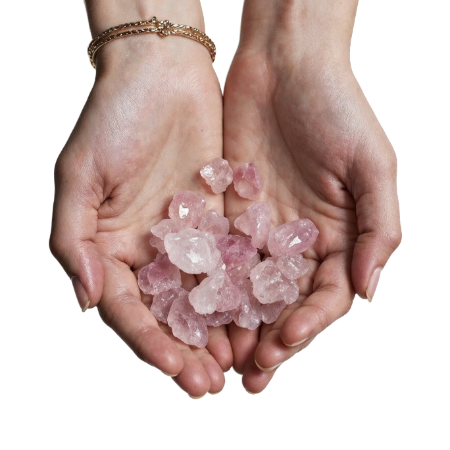
Rose quartz is a translucent pink to rose-red variety of quartz. It is rarely found as a crystal and is far more common in massive form.
Among gemstones, rose quartz is considered a semiprecious stone that may be used in jewelry. The earliest known use of rose quartz in civilization was in 7000 BC, where in archaeological sites, researchers have found beads made from Rose Quartz in Egypt and other ancient civilizations.
Rose quartz stones that are nearly transparent are sometimes cut to make flat surfaces called facets, to better reflect light. Rose quartz is also popular in the new age community for perceived metaphysical properties. (1)
Rose quartz has a hardness of 7 and no cleavage, which make it an excellent choice for any type of jewelry use. This quartz variety has long been known as an opaque to translucent gem material. Indeed, it remains a popular choice for spheres, beads, decorative objects, and other types of carvings as well as cabochons.
In the 1980s, transparent material was discovered in Madagascar. As a result, faceted rose quartzes entered the jewelry stone market.
With romantic associations due to its color as well as good durability, rose quartzes can make beautiful and affordable engagement ring stones. Rose quartzes are also considered alternative gemstones for 2nd and 5th wedding anniversary gifts.
Identifying Rose Quartzes
Rose quartzes cut as gems seldom show transparency, especially above 20-30 carats. Large spheres will appear milky at best.

Asterism, or the “star stone” effect, occurs rarely in quartz but is especially striking in rose quartzes. Since these gems may contain microscopic inclusions of rutile needles, cabs can sometimes show a six-rayed star when properly cut. Some cabs may display chatoyancy, a “cat’s eye” effect.
Rose quartzes may also display another phenomenal effect, Tyndall scattering, which occurs very rarely in gemstones. Fine particles of the appropriate size suspended in a medium can make light appear blue. While dust in the air makes the daytime sky blue, inclusions in some rose quartzes can turn all or part of the gem blue, when light strikes at the proper angle. This rare effect appears relatively frequently in Madagascar material.
Rose quartz may share its color with some other very popular gemstones, but its specific gravity (2.651) and refractive index range (1.544-1.553) can help readily distinguish it from pink varieties of sapphire, spinel, tourmaline, and topaz, as well as the more rarely encountered kunzite.
Be aware that rose quartzes are sometimes sold under the misleading names of “American Ruby” or “Bohemian Ruby.” Of course, quartz and ruby (corundum) are distinct gem species.
What is “Pink Quartz”?
Although rose quartzes receive their pink color from inclusions, researchers have discovered another rarer type of pink quartz that gets its color through a different process. Natural irradiation causes color centers based on aluminum (Al) or phosphorus (P) to replace silicon (Si) in the quartz atom lattice.

Although this quartz is still called “rose quartz,” some researchers have suggested naming it “pink quartz” to distinguish it from the more commonly encountered rose quartz, since it demonstrates some different physical and optical properties. Pink quartzes occur in euhedral or regular, distinct crystal shapes with well-formed faces, whereas rose quartzes occur in anhedral or irregular, intergrown crystal shapes with less distinct faces. Pink quartz may also show greater transparency.
Most significantly for jewelry use or display, pink quartzes have significant sensitivity to ultraviolet (UV) light. They can lose their color rapidly under exposure. Irradiation can restore the color.
In contrast, the more common rose quartzes don’t have this sensitivity. (2)
Is love on your mind?
Whether you’re searching for a new relationship, deepening a romantic partnership, learning to love yourself, or simply wanting to bring more love into your life, Rose Quartz crystals and jewelry are the perfect for you.

As a stone of love, the Rose Quartz meaning represents a powerful crystal for anyone seeking to bring more love into their life. The Rose Quartz healing properties connect to the heart chakra, the center of love. By opening and healing your heart center, the Rose Quartz chakra helps guide you to deepen relationships and embrace kindness, compassion, tenderness, and love toward yourself and those around you. (3)
Stone Sizes
Unlike most other colored crystalline quartz varieties, rose quartz doesn’t form large, facetable rough. Transparent gems rarely exceed 30 carats, although translucent specimens can weigh several pounds.
The Smithsonian Institution holds a sphere of Brazilian star rose quartz that weighs 615 carats.
Caring for Rose Quartzes
Since rose quartzes often contains inclusions, refrain from cleaning these gems with mechanical systems. Instead, use warm water, detergent, and a soft brush.
Reserve any jewelry made from the euhedral “pink quartz” variety for evening or occasional wear only. Store it in darkness, away from sunlight or other UV light sources, to preserve its color. (2)
Sources
(1) Wikipedia
(2) International Gem Society
(3) Energy Muse
In My Shop
Plush Pink Jewelry Sets
These Plush Pink Jewelry Sets are composed of 8mm Red Rhodochrosite, 6 & 8mm Natural Rose Quartz Gemstone, 10mm Orange Moonlight Sunstone, Gold-plated Spacer Beads, Bead Caps and Earring and Necklace Components
2 in stock










